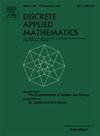The distance-edge-monitoring numbers of subdivision graphs
IF 1
3区 数学
Q3 MATHEMATICS, APPLIED
引用次数: 0
Abstract
For a vertex set and an edge of a connected graph , let be the set of pairs with and such that . For a vertex , let be the set of edges such that there exists a vertex satisfying in . A set of vertices of a graph is called a distance-edge-monitoring (DEM for short) set if, for every edge of , there exist vertices and such that belongs to all shortest paths between and . We denote by the size of a smallest DEM set of . Given a graph , subdividing one edge means removing the edge , adding an extra vertex , and adding the edges and . The subdivision graph of , denoted by , is obtained from the graph by subdividing all its edges. In this paper, we study the DEM numbers of subdivision graphs for various classes of graphs including trees, cycles, complete graphs, grids and friendship graphs. We show that for every positive integers with , there exists a graph such that and . Furthermore, we obtain sharp upper and lower bounds on and for every . We also give sufficient conditions under which achieves specific values of that are close to one of the bounds.
细分图的距离边监控数
对于连通图G的顶点集M和边e,设P(M,e)是对(x,y)的集合,其中x∈M,y∈V(G),且dG(x,y)≠dG - e(x,y)。顶点x,让EM (x)的边集e这样存在一个顶点v满足P (x, v)∈({x}, e)在G组M图G的顶点称为distance-edge-monitoring(民主党)设置,如果G的每条边e,存在顶点x∈M、y∈v (G), e属于x和y。我们之间的所有最短路径表示,民主党(G)的大小最小民主党G .给定一个图G,细分一个边缘紫外线意味着消除边缘紫外线,添加一个额外的顶点w,然后加上边uw和wv。G的细分图S(G)是对图G的所有边进行细分得到的。本文研究了树图、环图、完全图、网格图和友谊图等不同类型图的细分图DEM数。我们证明了对于每一个正整数a,b且1<;a≤b,存在一个图G使得dem(S(G))=a且dem(G)=b。进一步,对于每个x∈V(S(G)),我们得到|EM(x)|和dem(S(G))的明显上界和下界。我们还给出了S(G)达到dem(S(G))接近某一边界的特定值的充分条件。
本文章由计算机程序翻译,如有差异,请以英文原文为准。
求助全文
约1分钟内获得全文
求助全文
来源期刊

Discrete Applied Mathematics
数学-应用数学
CiteScore
2.30
自引率
9.10%
发文量
422
审稿时长
4.5 months
期刊介绍:
The aim of Discrete Applied Mathematics is to bring together research papers in different areas of algorithmic and applicable discrete mathematics as well as applications of combinatorial mathematics to informatics and various areas of science and technology. Contributions presented to the journal can be research papers, short notes, surveys, and possibly research problems. The "Communications" section will be devoted to the fastest possible publication of recent research results that are checked and recommended for publication by a member of the Editorial Board. The journal will also publish a limited number of book announcements as well as proceedings of conferences. These proceedings will be fully refereed and adhere to the normal standards of the journal.
Potential authors are advised to view the journal and the open calls-for-papers of special issues before submitting their manuscripts. Only high-quality, original work that is within the scope of the journal or the targeted special issue will be considered.
 求助内容:
求助内容: 应助结果提醒方式:
应助结果提醒方式:


